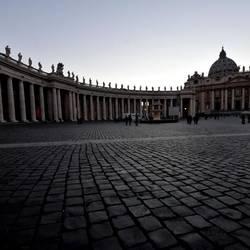Conclave to Start on 11 March
By Giacomo Galeazzi
In eight days cardinals will enter the Sistine Chapel for the start of the Conclave. This is the Church’s first Sunday without a Pope and there is no Angelus prayer today The window from which the Pope usually pronounces the Sunday Angelus prayer remained shut today. This is the Catholic Church’s first Sunday without a Pope. St. Peter’s Square is full of pilgrims but no one is looking up at the papal studio window because this Sunday no one will be appearing at it. The curtain has already come down on the great media circus surrounding the Conclave and the rosaries recited by faithful are the only thing that breaks the silence which fell after Benedict XVI’s departure. Now that the papacy is vacant, there is no longer any reference to Benedict XVI either as Pope or Bishop of Rome in the Eucharistic prayer during mass celebrations. Parish priests have prepared a new version of the prayer. As the Church strides towards the Conclave which is due to start on 11 March, the complete picture of Benedict XVI’s resignation is gradually forming. Ratzinger showed no less courage in resigning because “of the limits of old age and (…) the discernment on the exercise of responsibility that God had entrusted to him, than John Paul II who stuck it out until the end, despite his illness. Ratzinger’s decision is above all a reminder of one’s responsibilities, especially for cardinals who have the task of electing the Pope’s successor. On the Church’s second day without a Pope – day two of the sede vacante period – Fr. Federico Lombardi commented on the achievements of the outgoing pope, now Pope Emeritus, and their significance, also for those who will have to work with the choices that will shape the future of global Catholicism. To emphasise the spiritual nature of the papal election, the Vatican spokesman referred back to one of Wojtyla’s core texts with a preface signed by Joseph Ratzinger. “It is in right here, amidst this magnificent Sistine polychromy that cardinals meet – a community responsible for choosing the inheritor of the keys to the Kingdom. It meets in this very place. And Michaelangelo’s gaze still surrounds them.” It was 2003 when John Paul II wrote the “Roman Triptych”, a series of mediations on the Genesis and the threshold of the Sistine Chapel, in Polish. The poem is all the more meaningful now that cardinals are preparing to meet under Michaelangelo’s vault to elect St. Peter’s new successor. The Sistine Chapel is not just an artistic backdrop but also a kind of “theatre” set that has the power to influence the spirituality and conduct of the cardinal electors. This has been confirmed by those who have actually lived the experience. In his introduction to the apostolic constitution Universi dominici gregis (1996), Wojtyla laid down the rules for the sede vacante period and the election of a Pope, including this important passage: “I decree that the election will continue to take place in the Sistine Chapel, where everything is conducive to an awareness of the presence of God, in whose sight each person will one day be judged.” The general congregations will begin tomorrow morning with two sessions being held each day, in the lead up to the Conclave. Out of the 51 nations that will be represented in the next Conlave, Italy in theory has the most chances of one of its cardinals being elected (it has 29 cardinal Even if an Italian were to obtain all European cardinal electors’ votes (61 in total), he would still not have the necessary 78 votes - equivalent to two thirds of the 116 cardinal electors – to become Pope. The same applies to the Roman Curia which is represented by 38 electors, including current dicastery leaders and emeritus dicastery leaders who are not yet over 80. Re, for example, who will be presiding over the Conclave as he is the eldest of the cardinal bishops. The Curia bloc does therefore have the capacity to ensure cardinals do not elect a Pope it is not keen on but its influence does not extend to imposing one of its own candidates, unless it joins forces with another slightly larger group of cardinals (the Curia group makes up 40 votes). Even if a potential agreement were to be reached between Curia electors and Italian electors, this would not be enough to ensure the victory of one of their own because the advantage in terms of numbers would be negligible: out of the 28 Italian cardinal electors, as many as 20 are Curia members.
|
.
Any original material on these pages is copyright © BishopAccountability.org 2004. Reproduce freely with attribution.
